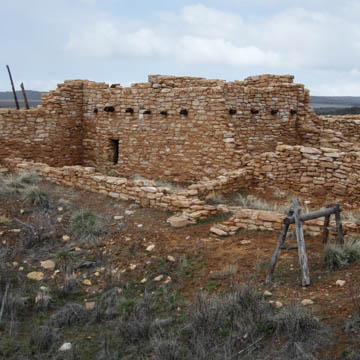The Edge of the Cedars Pueblo is situated north of the San Juan River and west of the Montezuma Canyon drainage. The prehistoric village has about a dozen great houses, of which Edge of the Cedars is the smallest. The area in which it is located was originally a Mesa Verdean province of the ancient southwestern world. Mesa Verde, in present-day Colorado near the Four Corners region, served as the cultural center of surrounding areas, including the Great Basin, the San Juan Basin, and the Rio Grande Valley, as evidenced by the variety of projectile points, food items, building techniques, and the incorporation of landscape elements discovered throughout the region. The ruin is the focal attraction of the present-day Edge of the Cedars State Park and Museum in Blanding.
Edge of the Cedars appears as a local attempt at a small-scale great house by people with some detailed knowledge of Chaco-style great houses. Chaco Canyon is located 200 miles away, in present-day New Mexico, and is known for its exceptional concentration of pueblos, spatial planning, construction techniques, great houses, and sacred kivas. Chacoan culture reached its apex between 900 and 1150, spreading its influence into the Mesa Verde region. Rubble-corned masonry, plastered-over tabular sandstone wall facings, intramural beams, and foundation trenches at the Edge of the Cedars suggest a great familiarity with the details of Chacoan architecture as well as a high level of interaction between the sites.
Edge of the Cedars consists of the remains of two superimposed villages dating to circa 800 and circa 1100, respectively. The later village consists of six rubble mounds and eleven associated depressions. Five of these mounds are single- or double-kiva household units with ground-level rooms on the north or west sides of circular depressions. These presumably mark the locations of partially filled household kivas or “round rooms.” In the middle of these mounds is a partially excavated and reconstructed sixth block. It has approximately twelve ground-floor rectangular rooms, two enclosed kivas, and a contiguous and exceptionally large and deep kiva depression.
The architectural details of this reconstructed block indicate that the structure was built in several construction stages. Three of the four largest rooms, which originally formed a rectangular structural core, were subdivided into two smaller rooms each, and the fourth was made host to one of the enclosed kivas. Tree-ring dating reveals that construction or remodeling took place between 1109 and 1117, and again around 1215. But it looks like this remodeling effort failed to generate significant reoccupation. There are few material traces of reuse. One of the kivas in this block, which has standard Chacoan features, was completely excavated between 1969 and 1973. It appears to have had a high, domed roof. It has a subfloor ventilation shaft and no deflector, as well as a subfloor vault west of the fire pit.
It is possible that local builders had previously observed or participated in the construction of Chacoan structures elsewhere or were privy to detailed information regarding architectural details appropriate for a truly Chacoesque great house. The features of this great house demonstrate that the local community engaged in widespread communication and ideational systems throughout the region, rather than remaining an isolated province at the fringes of the Anasazi world.
Unlike the impeccable masonry at Pueblo Bonita in Chaco Canyon, however, the quality of masonry here deteriorates about halfway up the walls. Carefully selected and tightly stacked slabs at the lower level give way to more block-like, irregular stones set in increasing amounts of mud chinked with sandstone spalls. The tabular sandstone masonry was apparently not intended to be seen, for the walls (of the excavated kiva at least) were completely covered with thick, unpainted plaster when first excavated. Some researchers have wondered if the deterioration of the quality of kiva masonry reflects a reevaluation of the relationship between labor costs and perceived value or if it implies a stronger degree of external involvement, i.e., oversight at the planning and early construction stages only.
In addition, the house has foundation trenches that don’t always align with the walls above. The foundation trench documented under the east wall of the northeast room of the Edge of the Cedars complex follows this pattern. The actual wall only partially overlaps the foundation trench. It could therefore be part of an instructional ground plan reflecting some degree of outside consultation or oversight in the initial stages of construction.
It is significant that the Edge of the Cedars great house was built over the ruins of a substantial Pueblo I period village; this placement is a recurrent pattern among Utah’s great houses. This may mean that if there was direct Chacoan involvement in the “outlier” great houses, it represented an invitation by long-established communities rather than the establishment of daughter colonies by an expanding Chacoan population in new territories.
References
Hurst, Winston B. “Chaco Outlier or Backwoods Pretender? A Provincial Great House at Edge of the Cedars Ruin, Utah.” In Great House Communities Across the Chacoan Landscape, edited by John Kanter and Nancy M. Mohoney, 63-78. Tucson: University of Arizona Press, 2000.
Hurst Winston B. and Jonathan D. Till. “A Brief Survey of Great Houses and Related Features in Southeastern Utah.” In Chaco and After in the Northern San Juan, edited by Catherine M. Cameron, 44-80. Tucson: University of Arizona Press, 2009.














